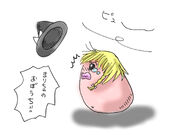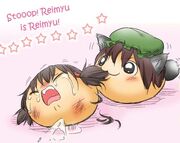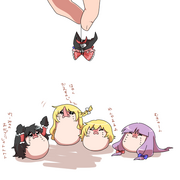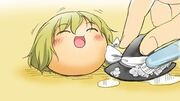An Accessory is a Yukkuri's decorative item, be it a hat, ribbon or whatever else. Generally they are based upon the headwear or item of the Touhou character the yukkuri is based on. In most cases, a yukkuri is born with its accessory, although sometimes[1] koyukkuri don't have complete accessories yet. They probably grow them at a later point in life. In most works, the accessory is just an item worn by the yukkuri, and it can easily be removed. Portrayals vary, however, and in very rare cases, the accessory is an attached body part. Despite being a separate item, the accessory grows with the yukkuri (via magic).

A gust of wind knocking off a Marisa's hat. These yukkuri suffer accessory loss the most.
The accessory is made of a material more resistant to water than the yukkuri itself, sometimes significantly (Yukkuri Marisas are sometimes shown using their hats as boats), and may have other properties too. In stories with edible yukkuris, it is still edible, though. See Theories.
An accessory that is lost or completely destroyed usually doesn't grow back; however, in some stories a kind Anon may repair a torn accessory, or acquire a new one from a Yukkuri Pet Shop , with the Yukkuri believing the Anon was somehow able to restore the accessory out of sheer magic. In other stories the accessory repairs itself, or even regrows, because of the Yukkuri Belief power (also named Yunhausen effect): for example in Between Studies an Anon manages to convince a Komarisa with a torn hat that, by clumping together with its saliva the pieces in a dumpling to keep always in contact with its skin, the hat would regrow by itself. Impossible at it seems, the hat regrows to its usual size and feature.
Losing Accessories[]
It is universally accepted that a yukkuri that has lost its accessory will be unhappy. This is explained in various ways:
- It's unhappy because it likes its accessory.
- It's unhappy because it's "disfigured" and "ugly" by yukkuri standards. This is actually quite consistent, because the accessory is pretty much like a body part, growing with the yukkuri.
- It just suffers because it's magically set up that way.
- It's unhappy and afraid because the accessory is the proof that the creature is a yukkuri, so without it, it is considered an animal, and so it fears peers' reaction. (It could be compared to a human who somehow finds himself in an ape body.)
- It's unhappy because it has the instinctual knowledge that it will be hated by other yukkuri for whatever reason.

A koyukkuri Chen bullying a non-accessory Reimu.
A yukkuri that has lost its accessory may pick up another one, which will work as a replacement. It's unclear if there are any limits to this. It's been theorized that an accessory from a dead yukkuri will not work, and, in the wild, stealing an accessory from a dead Yukkuri is a capital sin in the Yukkuri clan, leading to strong punishments, and even death, for the "Uneasy thief". Some stories imply that the accessory of a death yukkuri carries some "death stench", and thus is always recognizable, while the accessory of an alive yukkuri is "unmarked". However, the mere swapping of accessories may cause a sort of "identity theft", as, being all the yukkuri of the same type physically identical, they mostly recognize themselves by looking at their accessories.
However, under duress Yukkuris are more than willing to bypass their own laws; a wild Yukkuri may end stealing the accessory from a live Yukkuri, putting itself under the delusion to be "more deserving" than its intended victim, or that its victim actually stole or damaged its accessory first, thus deserving "punishment". Gutter Trash Yukkuris however, being under extreme duress and pressure, are able to fully bypass the veto against stolen accessories, with Yukkuris scraping a living by collecting accessories from the large number of dead individuals, fallen because of the harsh conditions of city life or because of the periodic "Mass Exterminations" and sell them to other yukkuris for a small fee.
Research material for this matter is scarce, because yukkuri very rarely manage to obtain replacement accessories and usually die trying. A notable exception comes from the accessories bought in a Yukkuri Pet Shop, or seen in Yukkuri Toys, obviously coming from dead yukkuris. However, when the human buys a new accessory for a pet yukkuri, usually doesn't explain it about its origins, thus hinting that the "death stench" of a recycled accessory is mostly a psychosomatic urge, or tied to the "Belief Power" yukkuris possess.
Earlier stories mentions a huge taboo about accessory theft, with a human girl stalked by several yukkuris for having mistakenly removed the ribbon from her Reimu , and yukkuris beaten to death for stealing accessories from a dead one.T hat story almost implied a sort of supernatural ability for yukkuris to recognize a thief, and the ability from large mobs of yukkuri to come aiding their wronged peer by literally stalking to death the human abuser.
However, with the evolution of yukkuris in the fanon, accessory abuse (theft or outright damaging) has become one of the most common ways employed by abusive anons to make yukkuris' lives more miserable without any fear of retribution. The wronged yukkuri, in current stories, will just try to resist the theft and then beg the thieving human to restore its accessory.
The attitudes of other yukkuri towards an accessory-less one typically evolve in a system that follows the following pattern:
- It is considered ugly, dirty or disfigured, but it is still possible for it to talk and play with other yukkuri (especially if they were of a different type).
- It grows unhappy, becoming even less appealing to others.
- To remedy the situation, the yukkuri tries to find a replacement accessory and fails.
- It attempts to steal an accessory in desperation, or it is suspected of planning that, perhaps as a result of a rumour.
- The others begin to fear accessory theft.
- The fear leads to anger against that yukkuri.
- The anger leads to hate againt the yukkuri.
- The hate leads to said yukkuri being killed or wounded by its peers.
A slight exception to this are Yukkuri Alices , which were portrayed very early as killing "hatless yukkuri" on sight, perhaps as a "city sect" custom. Sometimes the process will start at a later stage to speed up the story.
In some stories, the authors skip the whole evolution and jump straight to violence; an accessory-less yukkuri is instantly considered a threat to be eliminated by preemptive attack, or considered "not a yukkuri at all," but some disgusting and dangerous animal to be avoided or eliminated. With the progress and development of yukkuri as a whole, in some recent stories, the families of an accessory-less yukkuri are still able to recognise the yukkuri, but others will still regard it as trash. It may also depend on whether the family or yukkuri around witness the loss of the accessory; in some stories, if they do so, they are shown to be able to recognise the victim. Even so, a shithead peer may end refusing an accessoryless Yukkuri even if it witnessed the accessory loss or damage firsthand, refusing to be saddled with a peer unable to protect its "easiness". Conversely, a nicehead parent of sibiling, upon witnessing the loss, may actively try to cheer up the "disfigured" peer, searching actively from a replacement accessory and acting as they would with a wounded peer, saddened by its loss and willing to help.
It is also not uncommon for the accessory to be portrayed as an identification mechanism. Yukkuri that lose their accessories may become unrecognizable to less-intelligent or unfamiliar yukkuri, causing them to become instant strangers to other yukkuri. This may even occur between family members (see the drawing at right; the top-right koyukkuri is wondering "where did mommy go?"). This can be taken advantage of by bullies to promote identity confusion and sow discord in yukkuri clans.
In extreme cases, a Yukkuri parent may be tricked into bully and kill its own offspring; by removing the accessories from a litter of koyukkuris when the parents are out foraging, the returning parents won't be able to recognize their own litter. Instead, they'll viciously attack the "intruders", believing they drove away or killed their "easy little ones". This draws an uncanny parallelism with the human legends of the changelings, where in ancient cultures working class families and peasants often came under the assumption that a sudden illness, bringing disfigurement and mental disabilities, could be explained by a deformed, mind-addled "non-human" taking the place of an healthy, happy human kid.
Much as with the changelings, accessoryless koyukkuris would always end bullied and killed, with the parents then going away in search of their "Easy Little Ones", eventually forgetting about them or falling prey to the abusers responsible for the earlier trickery. Some stories have Stray Yukkuris sell their accessoryless offspring to support their "easy" little ones, loudly claiming to the Anon or buying yukkuri that the "Uneasy things stole my easy little ones".
Rarely, humans who are frequently associated with accessories, such as store employees who wear hats, may come to be identified via their accessories by yukkuri as well. Some stories bring that assumption to the extreme consequences, with a pet yukkuri unable to recognize its own "Owner" if the human stops wearing an accessory the pet has learned to associate with his presence, much as ties, ribbons and such.
Yukkuri who have lost their accessories have also been shown as looking for anything that might serve as a suitable replacement. (See below.)
Alternatives[]
There have been many works showing yukkuri with non-standard accessories, both natural or as a replacement for a lost or stolen accessory. The reaction of other yukkuri to this replacement accessory varies, from adoration in the case of Shell Marisa (a Marisa born with a shell instead of a hat) to general derision over having a shoddy accessory (such as a box or discarded ice cream cone). However, having an alternative accessory does appear to stave off attacks for not having any accessory. As a rule of thumb, replacing a stolen or a damaged accessory with an accessory of the same kind and shape always restores the "easiness" of the affected yukkuri, while using a shoddy replacement makes the Yukkuri feel ridiculed and disfigured, lowering its status in the eye of its peer to the point that, while a yukkuri with a shoddy accessory will still be recognized as a yukkuri, it will still be deemed uneasy by its peers.
The adoration for a naturally-born replacement accessory will be easily turned into derision when the "novelty" accessory is a mere replacement; counterfeit "Shelled Marisas" may be recognized because of the derision they'll always face from natural Shelled Marisas and regular Yukkuriras who, able to tell a "living" accessory from a counterfeit one, will call the switch and blame the counterfeit Yukkuri for having a shoddy, fake accessory.
Accessory with Pet Yukkuri[]

Teasing Kos with their accessories.
While not as easy to damage in home environments, owners of pet yukkuri should still take care to know what their pet's accessory is, such as a hat, ribbion, etc, and do their best to not damage it. While seemingly not hard to achieve, many novice yukkuri owners may end up damaging the accessory, either losing it or damaging it during play or other activities. Pet yukkuris are privileged in the fact that the owners can replace the lost accessory with another bought from a pet store. Though caution is advised when buying the accessory. It can be easy for a desperate owner to be tricked by a clever shop owner or even a yukkuri to buy a fake or damaged accessory.

A owner cleaning a koyukkuri Marsia's hat.
Some yukkuri pet guides recommend cleaning a dirty accessory. This should be done gently as to not damage the accessory. Much like pet clothes, the accessory should be dried beforehand in order to not get the yukkuri's head or body damp.
- ↑ In artwork by Tunusa.
